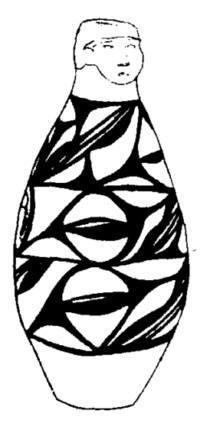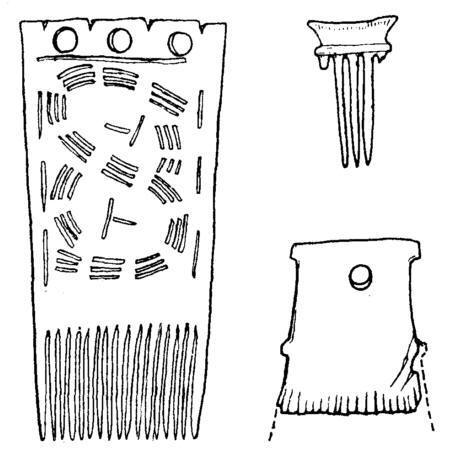Chapter 13 Chapter 1 The Tireless Pursuit
There is another fundamental difference between human beings and animals, which is that they appreciate beauty, love beautiful things, and create beauty with wisdom. Human beings are the messengers of beauty.
The love of beauty does not necessarily germinate after having a rich living condition.In the prehistoric era full of hardships and hardships, human beings started the pursuit of beauty very early, worked hard to beautify their living environment, and created countless wonderful works of art.At the same time, human beings are also constantly beautifying their own images and dressing themselves up as "works of art".It is such tireless pursuit that makes the supposedly ordinary prehistoric culture radiate brilliant brilliance.
Human beings' pursuit of beauty is first reflected in self-modification. In addition to the clothes mentioned above, this kind of modification also includes hair accessories and related accessories. These are two of the more important aspects of the many methods of beautifying the human body. Times are more important.
The hair of modern people, using modern means, can produce many novel hairstyles. In ancient times and prehistoric times, human beings also had some means to make various hairstyles that they thought were suitable and beautiful.Crowds of different cultural traditions have different hairstyles and unique aesthetics.Residents of different prehistoric cultural groups often use hairstyles as a clear sign of their differences. These hairstyles may mainly include loose hair, buns, and braided hair. Evidence of the existence of these hairstyles can be found on prehistoric pottery sculptures.
A painted pottery vase of the Yangshao culture was unearthed at the Dadiwan site in Qin'an, Gansu. The mouth of the vase is molded with a vivid human head, with short hair on the forehead and temples, and broken hair on the back of the head, which is flat on the earlobe. Unexpectedly, it may be the standard hairstyle of local adult men at that time.There are some painted sculptures and painted human heads on the pottery of Majiayao culture, and some drooping black lines are painted on the face. It is obviously a reflection of the custom of covering the face with hair, which is a popular hairstyle for young and middle-aged women.In addition, in Lixian County, Gansu Province, pottery figurine heads with braided hair coiled around their heads were also seen, indicating that the local custom of braiding hair is also present.A variety of hairstyles are also often used as symbols of people of different ages and genders (Figure 7).
A large number of bone hairpins unearthed at the Yangshao and Longshan cultural sites indicate that there is an ancient tradition of hairpins in the Central Plains. This tradition has continued into the civilized era and has become the standard hair style for men.In prehistoric tombs, some bone hairpins were unearthed and placed horizontally on the top of the deceased's head. This is the hairpin used as a hairpin on the top of the head. This hair style is called "vertebral bun".Hairpins are mostly ground from animal bones, and some are fired from clay, with various shapes.

Figure 7 Neolithic Humanoid Pottery Sculptures
Prehistoric people's emphasis on hair styles can also be seen from their elaborate hair combs.Prehistoric hair combs are made of ivory, bone and stone, and some are quite delicately processed.Residents of Dawenkou and Qujialing cultures have exquisite ivory combs with as many as 20 teeth.Bone combs are more commonly seen, while jade combs and stone combs are seen in Longshan culture.Some bone combs have only four or five teeth. It can be imagined that the earliest combs were made in the shape of fingers. Before the invention of combs, fingers were mainly used to comb hair.Later, the comb also became a kind of ornament, and it was kept behind the head. In the tombs of Dawenkou Culture, a dead man with two ivory combs on his head was found.Combing hair is an important part of beauty treatment, which is true in civilized society, as well as in prehistoric society.Don't imagine that prehistoric people all have disheveled hair, they also have the pursuit of hairdressing (Figure 8).

Figure 8 Neolithic ivory combs, bone combs and stone combs
In prehistoric times, there were not only neat hairstyles, but also various kinds of jewelry.A large number of ornaments have been unearthed from prehistoric sites, including those made of jade, mussel and dentin, as well as pottery. There may be many other organic ornaments that have not been preserved.There are many kinds of prehistoric ornaments, such as earrings, necklaces, bracelets, rings, etc. The parts of decoration range from the head, neck to the whole body, and even extend to the feet. The head and arms are the key decoration parts.
In the late Paleolithic Age, there were relatively simple decorations, which were generally small natural objects that had been slightly processed, such as animal teeth, fish bones, small stones, shells, etc., and were slightly polished to maintain their natural shape. After one hole, it is used as a pendant to hang on the body.The Neolithic Age began to have real artificial ornaments, which used more complex processing techniques, and many ornaments made of natural objects completely changed the natural shape.Ornaments may not be purely for beauty at the beginning, but later this purpose became more and more obvious, and the ornaments themselves became more and more exquisite.
People of different cultural traditions have different decoration styles and have their own characteristics.Residents of the Yangshao and Longshan cultures in the middle reaches of the Yellow River, in addition to bone, stone, and clam ornaments, also have a large number of ceramic ornaments, such as rings, beads, pipes, and bamboo sticks. Pottery rings have the largest number and are worn as bracelets.In a Yangshao tomb in Jiangzhai, Lintong, Shaanxi, a young woman wore a necklace made of bone beads, with a total of 8,721 beads. This shows how much the Yangshao people pay attention to jewelry.
Residents of Hongshan, Dawenkou, Longshan, Hemudu, Majiabang, Songze, and Liangzhu living along the eastern coast are popular with jade ornaments, and there are few or no ceramic ornaments.In the tomb of the Longshan Culture recently excavated in Zhufeng Village, Linqu, Shandong, a beautifully carved jade hairpin and jade hairpin were found, which are treasures among prehistoric ornaments.Among the Neolithic cultures in the Yangtze River Basin, a jade-shaped necklace is popular, which is a semi-circular ornament with perforations at both ends.The wearing method of this kind of jewelry with universal significance remains to be studied, and not all of them are necessarily necklaces.
Prehistoric architectural decoration also reflects people's pursuit of beauty.In the late Neolithic period, there was already the practice of painting walls and living surfaces. On the living surface of a Yangshao culture house site in Dadiwan, Qin'an, there were figures painted in black; The phenomenon of inner walls painted with vermilion was also found in row houses; around the stove pond in the center of the Longshan cultural house site in Henan, some of them used color to outline a wide circle; White gray walls; red geometric pattern murals are painted on the remnant walls of Qijia Cultural House in Guyuan Mahuang Jianzi, Ningxia.
The production of many utensils, the various shapes and colorful decorations of jade, bone and pottery reflect the tireless pursuit of beauty by prehistoric craftsmen.There are many other sculptures, as well as music and dance, which all reflect the spiritual world of prehistoric people.Let's take a rough look at the beauty created and admired by prehistoric ancestors only in terms of sculpture, painted pottery, music and dance.

Figure 7 Neolithic Humanoid Pottery Sculptures

Figure 8 Neolithic ivory combs, bone combs and stone combs
